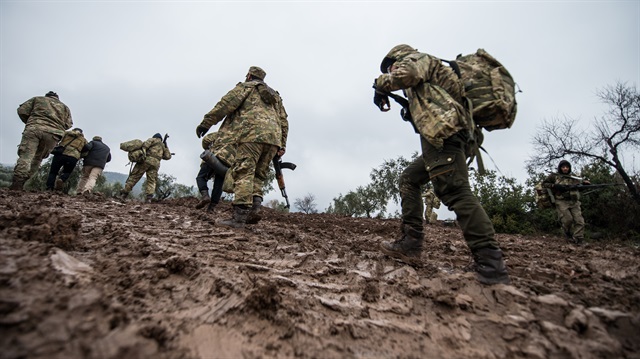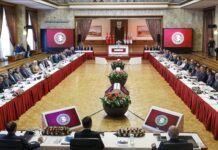On the streets and in the media, Turkey continues to wrestle with the problems of a modern, industrializing society. But Turkey’s specific circumstances also present challenges unique to its history, culture, and geographical position.
International security
January 2018 marks the first anniversary of the conclusion of Operation Euphrates Shield, which culminated in the push to secure Al-Bab in January and February of last year. The campaign was then declared completed in late-March 2017. Euphrates Shield continues to provide peace and security for Syrians rebuilding their lives in a swathe of north Syria extending from Jarablus to Al-Bab.
Several days ago the Turkish government initiated a new operation, this time aimed at eliminating the PKK/PYD enclave or salient in northwest Syria centered on the town of Afrin. This effort, codenamed Operation Olive Branch, was made possible by a series of U.S. missteps, further evidence of America’s inability to devise or execute a rational policy in the region.
The Turkish operation against Afrin was expected last summer but did not materialize. The most likely reason for the delay was Russian opposition. Russia had had troops in Afrin (cohabiting with the PKK/PYD) for the past several years, and may have seen its presence there as another bargaining chip vis-à-vis the U.S. It also did not want to incur friction with its client régime in Syria by allowing the Turkish air force into “Syrian” (but Russian-controlled) air space.
Turkey, on the other hand, was eager to remove the PKK/PYD from Afrin for several reasons. First, it did not and does not want a virtually continuous “Kurdish corridor” to emerge along its southern border as the potential territory of a future, PKK-controlled Kurdish statelet. Second, the mountainous regions along Afrin’s border with Turkey are already providing a route for the PKK to infiltrate Turkey. The Amanos mountain range runs south from Turkey’s border with Syria to the Mediterranean, from where the PKK is reported to have been using motor skiffs to slip militants and weapons to points further west along Turkey’s southern coastline.
Russian resistance to a Turkish incursion visibly weakened last year. Several months ago, for example, Turkey used the Astana agreement’s provisions for “control points” to move its forces into opposition-controlled territory around Idlib — a deployment that could only have happened with Russian acquiescence. But it wasn’t until the recent U.S. steps to build a fully-trained army of 30,000 in north Syria around the PKK/PYD as its core, and entrust “border security” to it, that Russia was finally persuaded of the validity of Turkey’s concerns and objections.
Events accelerated quickly over the last ten days as Turkey put the final touches on plans that had been developed much earlier. Russia withdrew its forces from Afrin, restrained the Asad régime, relaxed its control of Syrian air space — and Turkish tanks and ground troops, spearheaded by the Free Syrian Army, moved across the border. The Turkish troops in Idlib had already established the southern front. Once the PKK is eliminated from the province, says Turkey, Afrin will join Idlib and the Euphrates Shield region in a string of stable areas across north Syria, secured by the Turkish army and aided by Turkish NGOs, where Syrians can rebuild their lives and communities in peace, and from Damascus’s violence.
The long and short of it is that the U.S. have no one to blame for this development but themselves. The American military command’s continued insistence on arming and training a force long nurtured by an organization which is on its own list of “terrorist” groups will continue not only to blight relations with Turkey, but also to erode the standing of the U.S. across the region. We are at a point where few people in the Middle East can put any faith in what the U.S. administration promises.
Domestic security
The other, grimmer anniversary is that of the last wave serious violence in Turkey’s major cities, which lasted from mid-December 2016 to mid-January 2017. Even though the PKK, the DHKP-C, IS (or Daesh), and Fethullah Gülen’s cult are clearly continuing to plot against Turkey, developments since the failed coup attempt, and especially since Süleyman Soylu became Minister of the Interior, indicate that all these violent groups have experienced a dramatic decrease in their operational capacity.
The PKK, for example, now has great difficulty even crossing into Turkey, whether from Syria or north Iraq. Part of that is due to the wall constructed along much of the border, but the Turkish security forces’ increased use of armed and unarmed drones is also a major factor.
This drone capacity, by the way, is a largely domestically developed technology because Turkey’s allies starting with the U.S. have refused to provide such weapons for the security of a NATO ally. U.S. behavior over the past forty years, stretching back to the arms embargo imposed after Turkey’s intervention in northern Cyprus, taught the Turkish leadership that its defense and weapons capacities must be developed through its own efforts. Recent decisions by NATO members to deny Turkey access to key weapons technologies have served to further reinforce this lesson. Turkey now produces, in addition to all those armed and unarmed drones, armored combat vehicles, small frigate-class warships, and combat helicopters. The soldiers now wading through Afrin’s mud are armed with Turkey’s own automatic combat rifle recently put into mass production after satisfactory testing of prototypes (though the Free Syrian Army fighters shown above are still wielding AK-47s).
Finally, the steady rooting out of Gülen’s cultists from state institutions, including the army and the police, must be counted as an important contribution to the security apparatus’s improved performance. This has been achieved in the face of, or together with, innumerable claims that innocent people are being unjustly persecuted. Recent developments have illustrated just how difficult the task faced by the Turkish state is, given the intensely insidious nature of Gülen’s cult. For example, the messaging program ByLock, developed specifically by Gülen’s adherents for inner use, was identified by state investigators in early 2016 as the Gülenists’ main communication method (whereupon Gülen’s moles in the security forces warned their organization to switch to a different messaging service). The possession of ByLock on one’s phone has consequently been regarded as prima facie evidence for membership in Gülen’s cult. Just before New Year, however, we learned that more than 11,000 people had unknowingly had ByLock downloaded to their phones through malware developed by Gülenists in a deliberate effort to expose innocent people to prosecution. According to the Ankara State Procurator’s office, this meant that around a thousand people who had no evidence against them other than a phone with ByLock on it would be released from custody; that number was consequently raised to more than two thousand.
It has also been recently revealed that Gülen’s cult is working to maintain their contacts with their remaining adherents in the Turkish Armed Forces’ command structure through public pay phones and private land lines in locations like corner shops (bakkals), which are more difficult to identify than cell phone calls. Testimony from arrested Gülenists has led investigators to scrutinize more than 86,000 (not a misprint) calls made through pay phones and other land lines to members of the Turkish military. This means that the effort to expunge Gülenists from the Turkish Armed Forces still has a long way to go.













